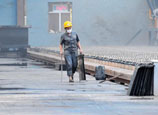
CANBERRA, July 17 (Xinhua) -- China released on Monday its economic data for the second quarter this year, which was closely monitored here by Australian economists and policy makers. A slower Chinese economic growth was calmly received, reflecting a much prepared and sober sentiment in an economy heavily dependent on China's growth.
The Chinese data showed the economy grew at an annual rate of 7. 5 percent in the June quarter, after 7.7 percent in the previous three months and 7.9 percent in the December quarter.
While the market expressed a sigh of relief that the June quarter outcome was in line with expectations, policy makers have focused the debate on a structural reform in the Australian economy in line with the structural reform in China.
Since taking office in late June, Prime Minister Kevin Rudd has been talking in a number of occasions about the end of China's mining boom. New Treasuer Chris Bowen also used his first economic note to reiterated the challenges for the economy as mining investment wanes amid a sluggish global recovery.
The announcement of the beginning of the ending of the mining boom was first made by then Resources and Energy Minister Martin Ferguson in September last year, when commodity prices began to see a downward trend.
Huw McKay, head of Asian Economic Research for Westpac Institutional Bank, said in an interview with Xinhua that the mining boom is entering the third stage -- exports. The first two stages, namely price boom and capex boom, are both mature.
Peter Drysdale, head of East Asian Bureau of Economics Research and East Asia Forum, Australian National University, also told Xinhua that the Australian mining boom is on the wane but it is far from over.
"There are still big energy projects in the pipeline and the capacity that is being put in place in the mining sector will deliver larger volumes into Chinese and other markets as prices come back."
He predicted that commodity prices will have to remain above pre-boom prices to maintain supply and Australia will gain a larger share in a tighter market because it remains among the most competitive resource suppliers in the world.
"In this context Chinese growth easing back to around 7.5 percent is no surprise to the mining sector," he said.

















 Teetering building demolished in Wuhan
Teetering building demolished in Wuhan


![]()
